The small basket with green and red roundish-oval fruits on my desk was everybody’s object of curiosity that day at office. My colleagues were intrigued as they had never seen fruits like these before. With subtle warnings of the extreme sourness and tanginess of the fruits, I encouraged everyone to try them. “Start with the red ones, they are less sour compared to the green ones,” my valuable tip to everyone. I had also kept a small bowl containing a mixture of salt and red chili powder to counter the tanginess of the fruits – that’s how we usually eat the raw fruit.
The reactions evoked by the fruits as people popped them into their mouths was priceless – squeezed eyes, numbed tongues and near chattering teeth. A colleague captured every single person’s reaction as Boomerang video clips making the fruit-tasting activity into a laughter exercise for all.
These green and red fruits are exotic and unique fruits from Meghalaya, locally known as ‘Sohphie Bah’ and ‘Sohphie Nam’ respectively.
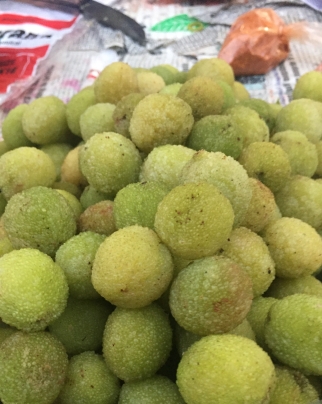
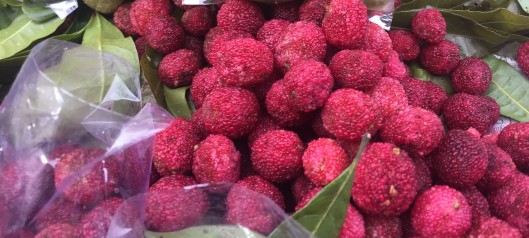
If you are in Shillong during the months of April through July, it is hard to miss these attractive and colorful fruits in cane baskets sold by roadside vendors almost everywhere. If you don’t have a tongue that can appreciate tanginess and sourness, this fruit is definitely not for you. I once prodded a friend from Bangalore to try them and the poor girl landed up with tiny blisters inside her mouth.
Sohphie (‘Soh’ meaning fruit is Khasi) marks the arrival of spring in Meghalaya and lasts through the summer but the fruit has a very short shelf life of just 2-3 days. The scientific name for Sophie Bah, the green variety, is Myrica esculenta and that of Sohphie Nam, the red variety, is Myrica nagi. Belonging to the Myricaceae family, these fruits grow all over Khasi, Jaintia and Garo Hills. Variants of the fruit are also found in other places of the Himalayan region at altitudes of 1,300-2,000m.
Enriched in phytochemicals, Sohphie has several medicinal properties. Rich in Vitamin A and C, Sohphie is anti-allergic, anti-diabetic, anti-oxidant and anti-inflammatory. The bark of the tree is used as an aromatic, a stimulant, an astringent, and as an antiseptic in indigenous medicines. It is also used to cure asthma, fever, chronic bronchitis, lung infections and toothache. The leaf and roots are used in indigenous medicines to treat worms and jaundice.
The fruit is not only relished raw but used to make pickles and jams. Sometimes you’ll find the pickles being sold by roadside vendors, where you needn’t buy the entire jar but they give you some in a piece of paper to be devoured then and there. Now, the very thought of that makes my mouth water and I want some right away!
By the way, have you heard of Tree Tomatoes? Read here.
Some Other Exotic Fruits From Meghalaya
Sohiong (Prunus nepalensis)
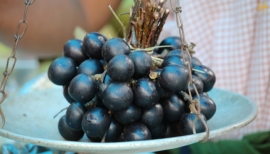
Sohiong, which literally means ‘black fruit’ in Khasi, are delightfully rounded, marble-like, purple coloured fruits. These seasonal fruits are available only for a very short period – from late August till mid-October. Rich in nutrients and antioxidants, this fruit can be eaten raw though the jams, desserts, and wines made from the fruit are more popular. The raw fruit leaves behind a stain of deep purple on the lips and tongue. As kids, we would paint our lips purple and play grown-ups wearing lipstick. And that used to be our primary reason for relishing Sohiong. Nostalgic! The colours can be extracted to make natural edible food colours too.
Sohshang (Eleagnus khasianum)
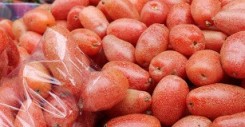 It’s weird but Sohshang just reminded me of Barbie dolls. Perhaps it’s the somewhat transparent light pink colour with minute white dots all over it. These oval-shaped pulpy fruits are again seasonal and available only during March and April. They are a rich source of vitamin C and minerals like calcium, magnesium, potassium, phosphorus. Sohshang is eaten raw as well as pickled.
It’s weird but Sohshang just reminded me of Barbie dolls. Perhaps it’s the somewhat transparent light pink colour with minute white dots all over it. These oval-shaped pulpy fruits are again seasonal and available only during March and April. They are a rich source of vitamin C and minerals like calcium, magnesium, potassium, phosphorus. Sohshang is eaten raw as well as pickled.
Sohphlang (Flemingia vestita)
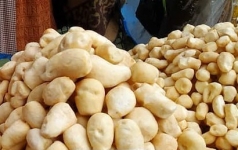
‘Soh’ means fruit in Khasi and ‘Phlang’ means grass. Whether Sohphlang is a fruit or a vegetable is perhaps debatable as it is actually a tuber. This pale white, shapeless fruit/vegetable is somewhat unattractive as compared to the other fruits and berries of this region. Rich in phosphorus and proteins, it has a crunchy taste. It can be eaten raw or cooked and is available from October to May.
Have never heard or seen any of them despite the fact that over the years people in Florida have been raising and selling more varieties of fruits exotic to the U.S.
LikeLiked by 1 person
After the comment above, I went on to read the article on tree tomatoes; all those items can be found in our local markets.
LikeLiked by 1 person
These are typical fruits of a particular state in North East India, Meghalaya. So it is unlikely you may see them in other places. 🙂
Tree Tomatoes are found in many place across the world. Thank you Ralie for reading my post.
LikeLike
Interesting to know about Sophie! Nice read…
LikeLiked by 2 people
Thank for for reading 🙂
LikeLiked by 1 person
Thanks for sharing these unknown fruits, Neel. The red one reminds me of a fruit I had in Uttarakand many years ago. It’s called Kaphal. It seems closer to this one. Locals have it with salt. I never knew there are so many exotic fruits in NE. Are these sold commercially in the local market?
LikeLiked by 2 people
Kaphal is a variant of Sophie I guess. I have had it too. Yes they are sold commercially in the local market but I think they can have a much larger market out of Meghalaya too.
LikeLiked by 2 people
I concur. 🙂
LikeLiked by 1 person
Such an informative post this is – never heard of any of these fruits before. At first glance, before i read the info, I mistook Sohshang and Sohphlang for potato varieties. Thanks for sharing!
LikeLiked by 2 people
Thanks for reading, Narendra. Thought you might like to know about these unique fruits 🙂
LikeLiked by 1 person
You know me well! 🙂
There’s so much to discover and learn about that this lifetime is inadequate; and your posts always make me feel like pushing aside the clutter, get up, and run to mother nature!
LikeLiked by 1 person
Now that puts me on Cloud-9 🙂
And true that there is too much to know and discover, even a few lifetimes wouldn’t be enough!
LikeLiked by 1 person
So that’s three good reasons why I should visit Meghalaya in summer. Are these available in markets in Shillong?
LikeLiked by 1 person
Haha….yes they are available everywhere during the months of April to July. You’ll find them being sold in abundance by the roadside in Police Bazar and other places as well.
LikeLiked by 1 person
Well-researched and quite an interesting article. How do sohiong and sohshong taste like? The former looks like blackberry (jamun)? Does it taste like that too? Then it definitely not up my alley.😄
LikeLiked by 2 people
Sohiong is very very tasty, especially the chutney. The chutney is even offered to Ma Durga in bhog 🙂
It tastes nothing like jamun, it has a distinctive taste of its own. If you ever have an opportunity to taste it, don’t miss it. Sohshang is pretty tangy, fleshy, and juicy. Sohiong is not so much fleshy, it has a very big rounded seed, which makes for the bulk of the fruit.
Thank you once again Anushtup! You delight me with your interests. Most people wouldn’t have the patience to read long posts. 🙂
LikeLiked by 1 person
Your blogs are indeed tasty – sweet, spicy, tangy and everything in between, with a few ‘sour’ and ‘bitter’ experiences thrown in good measure.😉😃
LikeLiked by 1 person
Haha! Thanks again. 😀
LikeLiked by 1 person
No never heard but they really look exotic 🙂
LikeLiked by 2 people
Wow! Good to learn about such a wide variety of fruits. All of them are really unique with different shapes and colors and have interesting names too.
LikeLiked by 2 people
Thanks Hariom, not just for reading and commenting on my post but for visiting WordPress as well 😀
LikeLike
Your blog seems to be interesting and I felt definitely to follow your writings.
I haven’t seen those before.Thank you sharing !
LikeLiked by 1 person
Thank you Athira. I will go check your blog too.
LikeLiked by 1 person
Ohh..thanks a lot in advance !
LikeLike
Interesting. I started reading it as the name sounds the same that of Canada’s prime minister’s wife Sophie.
LikeLiked by 1 person
Haha…..the name of a woman, turns out to be a fruit !
LikeLiked by 1 person